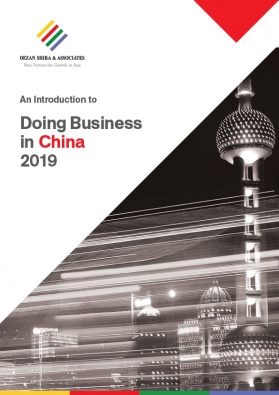US Tariffs on China – What Has Been the Response?
As the calendar turns to 2019, the trade war between the US and China appears far from reaching a resolution. While Chinese President Xi Jinping and US President Donald Drumpf struck a deal to call a trade truce at the recent G20 summit, significant gaps between the two sides remain.
Yet, despite the US tariffs on China taking their toll – the country’s biggest economic challenge since the 2008 global financial crisis – the Chinese response has been characterized by relative restraint.
Rather than pour in billions in financial stimulus, as it did a decade ago, the government has introduced several targeted measures to reduce costs for businesses and consumers, and, more crucially, advance and expedite its broader reform agenda.
Here, we look at how China is bolstering its economy to mitigate the impacts of the trade war.
Diversifying trade and free trade agreements
Chinese exporters are staring at heightened tariffs when selling to the US, while importers of US goods have been hit with China’s own retaliatory tariffs.
Since the trade war erupted, China has slapped additional tariffs ranging from five to 25 percent on US$110 billion worth of US exports. This has meant that Chinese consumers and businesses face extra costs for importing almost any product from the US.
The extra tariffs are becoming a significant deterrent to Chinese importers: in November, China’s imports from the US declined by a drastic 25 percent year-on-year. The dramatic decline partly reflects China’s efforts to deepen relationships with alternative trade partners.
For example, beginning July 1, 2018, China cut tariffs for imports originating from India, South Korea, Bangladesh, Laos, and Sri Lanka. Among the products affected by these cuts were soybeans – a product that China imported US$13.9 billion worth of from the US in 2017.
More recently, in its ongoing attempts to broaden trade partnerships, China pledged to import more agricultural products from India. Mutual interest in hedging against US trade actions even led to a rapprochement between China and Japan, who are traditionally regional competitors. Prime Minister Shinzo Abe paid his first visit to China – the first official visit by a Japanese leader in seven years – and said the two countries were shifting from competition to cooperation.
Beyond pursuing new trade channels in the immediate term, Beijing has injected fresh urgency into finalizing larger free trade agreements (FTAs). The most notable of these is the RCEP, a mega trade deal that includes China, Japan, South Korea, Australia, New Zealand, India, and the 10 ASEAN members. Although the parties to the RCEP failed to conclude the deal by the end of this year, they are expected to do so in 2019.
The Chinese government recently upgraded its FTA with Singapore, is exploring the possibility of a China-Japan-South Korea FTA, and has opened talks on an FTA with Panama. China was also pursuing an FTA with Canada, although the prospects of that agreement look grim due to their ongoing diplomatic skirmish and the recent signing of the USMCA.
Simultaneous tariff cuts, tax reforms
In addition to deepening links with alternative trade partners, China has cut costs for both businesses and consumers to cushion the impact of the trade war.
On July 1 – the same day as the first round of US tariffs went into effect – China’s tariff cuts on 1,449 categories of goods came into force. This lowered tariffs on consumer products like apparel, cosmetics, and home appliances.
Then, as of November 1, China cut tariffs on a further 1,585 taxable items. This round largely targeted industrial products and materials used for manufacturing, such as electronic equipment, textiles, building materials, and paper.
To ease the strain on China-based exporters – who are among the hardest hit by tariffs – China first increased export tax rebates for 397 products, and then later increased export tax rebates rates more broadly.
For companies struggling under trade war pressure and considering downsizing, China recently announced incentives that would enable them to lower their unemployment insurance obligations.
Moreover, China has expedited its individual income tax (IIT) reform to lessen the burden on low- and middle-income earners and encourage consumption. The new tax brackets took effect on October 1 – only a month after the law was passed – while the rest of the provisions will come into force on January 1, 2019.
Attracting investment to counter trade war effects
China has made great strides in improving its business environment over the past year, with the trade war speeding up forecasted improvements.
Most of China’s improvements have come as a series of small but impactful measures to cut red tape and streamline business administration. This continues to be the case with new policies pushing for greater investment and trade facilitation, such as streamlined customs procedures.
The Chinese government is hoping to combine such improvements to the business environment with targeted incentives to attract investment. On July 31, the central government directed regional governments to roll-out policies to maintain economic stability – in other words, to bolster local economies in the face of the trade war.
Regional governments have responded in kind at both the provincial and the municipal level, with policies like one-time cash rewards, infrastructure investments, and reduced business costs.
China has even made moves to improve its intellectual property (IP) rights, which is an issue on the forefront of US complaints of China. Developments in this regard include the establishment of a dedicated national-level IP court and stricter IP violation punishments.
Spurring China’s economy
In response to the uncertainty caused by the trade war, China has accelerated stimulus to spur its economy – to an extent.
For example, in late October, China’s central bank made plans to provide RMB 10 billion (US$1.4 billion) in credit support to stimulate private lending, and previously announced new infrastructure spending increases. Further, in November, the State Council encouraged government departments to boost lending, especially to small and micro businesses.
However, the government’s stimulus measures to date pale in comparison to previous levels. China is unable – or unwilling – to resort to large-scale stimulus to accelerate the economy because it is still heavily indebted from its massive spending during the global financial crisis.
In 2008, China unveiled an enormous RMB 4 trillion (US$600 billion) stimulus package, which was worth nearly 13 percent of the country’s GDP that year. In comparison, the US stimulus package – considered large in its own right – was worth US$152 billion. According to the Institute of International Finance, China’s total debt may have surpassed 300 percent of GDP in Q3 2018.
In response, reducing debt and financial risk has been one of the highest priorities of the Chinese government over the last two years, and remains so despite China’s current economic pressures.
That means local governments and financial institutions are faced with the contradictory goals of simultaneously boosting lending and reducing debt. While this means that policy priorities may be unclear at the local level, it makes sure that any government spending is targeted and cautious rather than expansive and costly.
Speeding up domestic reforms
Nearly half a year into the trade war with the US, China’s efforts to bolster its economy are relatively targeted and restrained.
Some measures, like export tax rebates and incentives to avoid layoffs, are clearly designed as interim relief measures for firms impacted by tariffs and trade friction.
Many other measures, however, appear to be speeding up the government’s pre-existing reform agenda. RCEP, tariff and tax cuts, and the IIT reform are among policies that were already planned, but likely fast-tracked due to the trade war.
These policies may offer tangible benefits to reduce the pain felt by companies hurt by the trade war, but do not compare to the scale of the government’s response during its last major economic challenge. And for businesses already considering a shift to lower-cost destinations like Vietnam due to broader economic trends, government support is unlikely to change their calculus.
Nevertheless, China’s strategy could be beneficial to the country’s economic outlook beyond the trade war. Moving forward with the structural transition towards domestic consumption and high-tech innovation will pay high dividends in the mid- to long-term. However, as the trade war heads into 2019 and its impact gets real, shorter-term emergency measures could quickly climb to the top of the agenda.
About Us
China Briefing is produced by Dezan Shira & Associates. The firm assists foreign investors throughout Asia and maintains offices in China, Hong Kong, Indonesia, Singapore, Russia, and Vietnam. Please contact info@dezshira.com or visit our website at www.dezshira.com.
- Previous Article Norway and Sichuan Build Belt and Road Arctic Bridge
- Next Article Hong Kong’s 2019 Holiday Schedule























